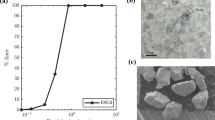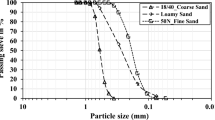Abstract
Predicted and measured water-retention values,θ(ψ), were compared for repacked, stratified core samples consisting of either a sand with a stone-bearing layer or a sand with a clay loam layer in various spatial orientations. Stratified core samples were packed in submersible pressure outflow cells, then water-retention measurements were performed between matric potentials,ψ, of 0 to -100 kPa. Predictions ofθ(ψ) were based on a simple volume-averaging model using estimates of the relative fraction andθ(ψ) values of each textural component within a stratified sample. In general, predictedθ(ψ) curves resembled measured curves well, except at higher saturations in a sample consisting of a clay loam layer over a sand layer. In this case, the model averaged the air-entry of both materials, while the air-entry of the sample was controlled by the clay loam in contact with the cell's air-pressure inlet. In situ, avenues for air-entry generally exist around clay layers, so that the model should adequately predict air-entry for stratified formations regardless of spatial orientation of fine versus coarse layers. Agreement between measured and predicted volumetric water contents,θ, was variable though encouraging, with mean differences between measured and predictedθ values in the range of 10%. Differences inθ of this magnitude are expected due to variability in pore structure between samples, and do not indicate inherent problems with the volume averaging model. This suggets that explicit modeling of stratified formations through detailed characterization of the stratigraphy has the potential of yielding accurateθ(ψ) values. However, hydraulic-equilibration times were distinctly different for each variation in spatial orientation of textural layering, indicating that transient behavior during drainage in stratified formations is highly sensitive to the stratigraphic sequence of textural components, as well as the volume fraction of each textural component in a formation. This indicates that prolonged residence times of water, nutrients, and pollutants are likely within finer-textured layers, whenψ conditions have resulted in drainage of underlying coarser-textured strata.
Similar content being viewed by others
References
Bouwer, H. and Rice, R. C., 1984, Hydraulic properties of stony vadose zones,Groundwater 22(6), 696–705.
Campbell, G. S., 1985,Soil Physics with Basic, Developments in soil science, 14, Elsevier, New York.
Coile, T. S., 1953, Moisture content of small stones in soil,Soil Sci. 75(3), 203–207.
Constantz, J., 1993, Confirmation of rate-dependent behavior in water retention during drainage in nonswelling porous material,Water Resour. Res. 29(4), 1331–1334.
Constantz, J. and Herkelrath, N. W., 1984, Submersible pressure outflow cell for measurement of soil water retention and diffusivity from 5 to 95‡C,Soil Sci. Soc. Am. J. 48(1), 7–10.
de Vries, D. A., 1963, Thermal properties of soils. In W. R. van Wijk (ed),Physics of Plant Environments, North-Holland, Amsterdam, 210–235.
Ferrand, L. A. and Celia, M. C., 1992, The effects of heterogeneity on the drainage capillary pressure-saturation relation,Water Resour. Res. 28(3), 859–870.
Gardner, W. H., 1977, Historical highlights in American soil physics,Soil Sci. Soc. Am. J. 41(2), 221–229.
Gelhar, L. W., 1986, Stochastic subsurface hydrology from theory to applications,Water Resour. Res. 22(9), 135S-145S.
Hanson, C. T. and Blevins, R. L., 1979, Soil water in coarse fragments,Soil Sci. Soc. Am. J. 43(4), 819–820.
Lappala, E. G., Healy, R. W. and Weeks, E. P., 1987, Documentation of computer program VS2D to solve the equation of fluid flow in variably saturated porous media, U.S.G.S.Water Resour. Inv. Rep. 83-4099, pp. 184.
Nash, M. S. and Flint, A. L., 1993, Determination of water retention characteristics of a skeletal soil at Yucca Mountain,Agronomy Abstr., Amer. Soc. Agronomy, p. 214.
Quintard, M., Bertin, H. and Whitaker, S., 1989, Two-phase flow in heterogeneous porous media: The method of large-scale averaging applied to laboratory experiments in a stratified system,Pap. 19682, Soc. Pet Eng., Richardson, Tex.
Tyler, S. W. and Wheatcraft, S. W., 1990, Fractal processes in soil water retention,Water Resour. Res. 26(5), 1047–1054.
Warrick, A. R. and Nielsen, D. R., 1980, Spatial variability of soil physical properties, in D. Hillel (ed),Applications of Soil Physics, Academic Press, New York, pp. 319–334.
Willis, W. O., 1960, Evaporation from layered soils in the presence of a water table,Soil Sci. Soc. Am. Proc. 24(4), 239–242.
Yeh, T.-C., Gelhar, L. W. and Gutjahr, A. L., 1985, Stochastic analysis of unsaturated flow in heterogeneous soils, 1. Statistically isotropic media,Water Resour. Res. 21(4), 447–456.
Author information
Authors and Affiliations
Rights and permissions
About this article
Cite this article
Constantz, J. Determination of water retention in stratified porous materials. Transp Porous Med 18, 217–229 (1995). https://doi.org/10.1007/BF00616932
Received:
Revised:
Published:
Issue Date:
DOI: https://doi.org/10.1007/BF00616932




